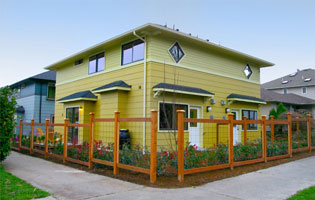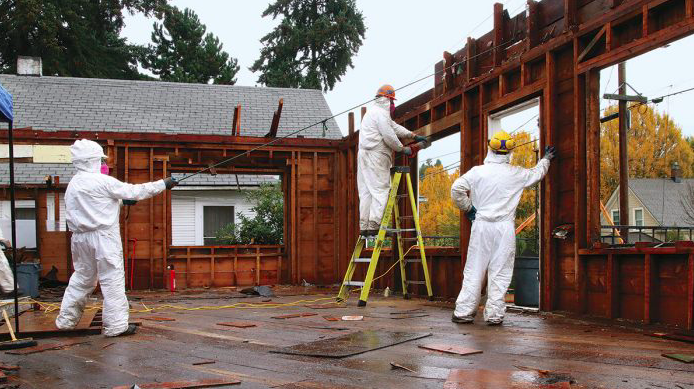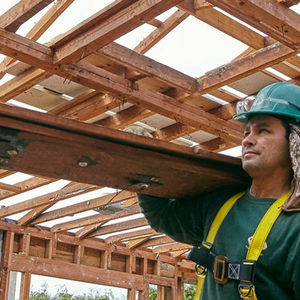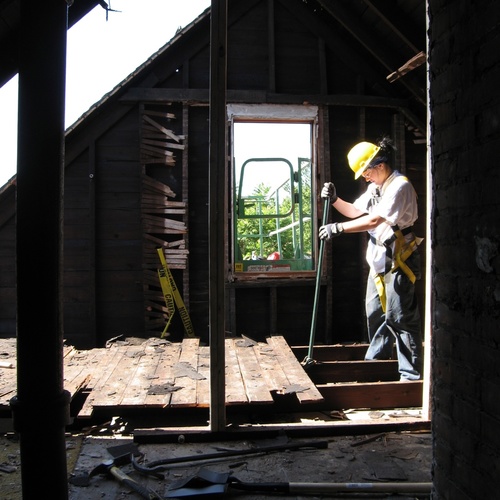
Image Credit: Greenleaf Construction Inc.
Making ecological sense of building deconstruction has been easier than reckoning with its economics. But the Seattle area is giving salvage a serious shot
Financial considerations aside, it isn’t that hard to come up with good reasons, including ecological ones, for salvaging material from buildings that would otherwise be demolished and end up in landfill.
Lumber, fixtures, and decorative artifacts pulled from existing buildings can be reused locally, often to the immense satisfaction of builders, remodelers, and homeowners who prize the stuff for its beauty, high quality, practicality and, in some cases, historic value. It’s the recycling ethic in fine, glorious form.
But then there’s the economics of it all. The speed of straightforward demolition can be attractive to builders who don’t want to spend the money on labor and take the time needed to deconstruct a building for salvageable and recyclable materials.
A code adjustment
Expedience is a powerful motivator. The Seattle area, however, has turned into something of a proving ground for alternative approaches. Deconstruction specialists in the region, including RE-USE Consulting, based in Bellingham, Washington, and Earthwise Architectural Salvage, based in Seattle, likely would argue that the ultimate cost of harvesting reusable and recyclable materials on a project may be competitive with that for demolition, particularly when efficient disassembly techniques are used and dump fees for heavy materials are factored in.
Seattle is relatively accommodating to deconstruction firms, although it wasn’t always that way. One constraint for builders was a code regulation that allowed a residential demolition permit to be issued only when an associated permit for new housing had also been issued. That meant little time for deconstruction – if that was a consideration for the project – and left builders more inclined toward demolition. In March, however, Seattle’s Department of Planning and Development created a permitting option that allows a demolition permit to be granted well in advance of a housing permit to contractors who want to salvage and/or reuse materials from the existing structure.
“We have a minimum percentage of materials that need to be salvaged and reused or recycled with the goal that we’re diverting materials from the landfill and encouraging the use of the materials,” DPD official Sandra Mallory told the Ballard News-Tribune.
Treasure hunters
An extensive look at the Seattle area’s deconstruction movement, published this week by the Seattle Times, notes unswerving enthusiasm for the process among some builders, such as Greenleaf Construction, and of course local salvage retailers such as the RE Store and Second Use Building Materials, both based in Seattle.
“I’m an old-fashioned redneck,” Greenleaf owner Jim Barger told the paper. “I used to be ‘Yahoo! Bring ‘er down!’ But I can’t do it anymore.”
Indeed, the salvage bug can bite at any time. Early this month, GBA posted a blog about two brothers who bought a 100-year-old home in South Chicago and decided, after checking out the condition of its foundation, to reconstruct the house to deep green rather than raze it. One of the brothers, Tim Heppner, is a carpenter. He did much of the work on the building and found plenty to like as he deconstructed the interior.
In the home’s detached garage, Heppner stored all of the useable wood he extracted from the house. Most of it has since found its way back into the home’s reconstruction. “The wood came from old-growth forest,” Heppner marveled. “It was amazing to see 2x4s with 65 grains across.”
Weekly Newsletter
Get building science and energy efficiency advice, plus special offers, in your inbox.















One Comment
Rethinking Material Reuse
The Reuse credit is one of the underutilized credits. It is hard to economically justify with so many other easier to obtain credits to choose from. It is my observation that many in the LEED community consider material reuse to exist within the narrow domain of salvage strategy. From an economic perspective, salvage is too expensive to make the material reuse credit acceptable to the budget centric Owner. From a quality perspective, salvage material is too variable to be acceptable unless creative effort (ie. cost) is applied to make it acceptable. Having said that, I want as much as the next person to see salvage become a more widely accepted material. I tip my hat to all the risk takers out there who are positioning themselves as salvage and building material reuse contractors. For they are in a market space before it's time. I tip my hat to all the designers out there who apply creative effort to make slavaged materials acceptable within the project. But the fact is Reuse is not widely used and when it is, it is associated with projects penetrating the thinner air of gold and platinum certification. Judging the products and assemblies used to meet the credit, architectural artifacts and high end items, the Owners paid a premium to obtain the credit. This premium paying behaivior is counter to the idea that green should cost no more than conventional, and it is patronizing to the intent of material reuse which is to keep construction and building demo waste out of the land fill and preserving the embodied energy of good useable materials. Little is kept out of the dump and little energy is preserved when only one or two items are being preserved to meet the credit.
I am doing research into a market driven solution that begs the LEED community to widen its view of material reuse to include project leftovers. The stuff contractors overbuy to ensure 1) no "stock outs" on the job and 2) comply with attic stock req's. Typical contractor management strategy with respect to this resource is to store it until it can be resold into future project thus obtaining a high net recovery value on excess inventory. Kind of like all the bankers today with mortgages in arrears are waiting for the real estate market to recover to recoup their investment, meanwhile houses get foreclosed, sit vacant, and go into disrepair. My hypothesis is that as the EXPECTED net recovery value of this left over stuff declines the likelyhood this stuff ends up in the dump increases. The key term here is management's expectation. So long as management believes it can get high value, management keeps the stuff. When value is no longer expected, management makes a decision. In our study we assume the storage constraint is at capacity thus the contributing factor to making a decision is when the firm needs that storage resource for higher value product. ie new stock for the next building cycle. Here we find management's focus is on managing new work profitably and not on material with little residual value. Also we explain transaction costs asscoiated with charitable contributions may exceed the benefit. We cite profit surveys of trade that indicate a charitable write offs may be of little value to the break even firm exacerbating the disinclination to give.
What does this mean? We estimate that $4 Billion in good used product is earmarked for the dump each year. The material represents a significant impact on the extration of virgin resources, and the use of fossil fuels in production and transport of the product. We suggest if the material is compliant under the intent of the LEED material reuse credit, and by leveraging the supply chain with a market driven solution, we can make the MR 3.1 and 3.2 credit an economically feasible reality. We also suggest that once the market is established it can also serve to eliminate the uncertainty associated with wider acceptance of everday salvaged material like those recovered from demolition projects. A two fer one deal.
What do you think?
Log in or create an account to post a comment.
Sign up Log in